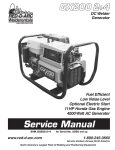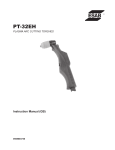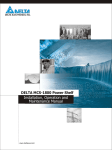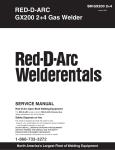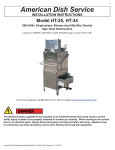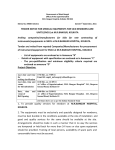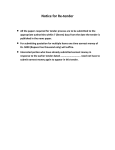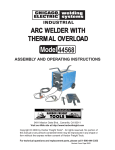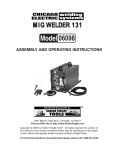Download Chicago Electric MIG-100 91124 Operating instructions
Transcript
MIG-100 WELDER WITH THERMAL OVERLOAD 91124 ASSEMBLY AND OPERATING INSTRUCTIONS ® 3491 Mission Oaks Blvd., Camarillo, CA 93011 Visit our Web site at http://www.harborfreight.com Copyright© 2004 by Harbor Freight Tools®. All rights reserved. No portion of this manual or any artwork contained herein may be reproduced in any shape or form without the express written consent of Harbor Freight Tools. For technical questions and replacement parts, please call 1-800-444-3353. REVISED 12/04 Specifications ITEM DESCRIPTION Welding Current Duty Cycle Power Consumption Heat Control Switch on Unit Ground Cable Torch Power Cable Power Cord Power Cord Plug Thermal Overload Welder Tip Wire Size Wire Spool Size Overall Dimensions Weight Accessories 90 AMPs 10%@90AMPs 110VAC, 23 amps This model is not adjustable 4 AWG, single insulation, 6 foot 8 AWG, single insulation, 6 foot 3-core, double insulated, 14 AWG, U.L. approved UL Approved Both settings: 10 min. shutdown, 3 min. back on with Light 0.030”; Spare: Welder Tip 0.035 inch; Will also accept 0.023” welder tip 0.030 inch flux core wire when using 0.030” Welder Tip 4 inches diameter 14-1/2 (L) x 8-1/2 (W) x 15-1/2 (H) inches 34.45 lbs. Spare Welder Tip Welding Face Shield Wire Brush / Hammer combination Save This Manual You will need the manual for the safety warnings and precautions, assembly instructions, operating and maintenance procedures, parts list and diagram. Keep your invoice with this manual. Write the invoice number on the inside of the front cover. Keep the manual and invoice in a safe and dry place for future reference. Safety Warnings and Precautions WARNING: When using tool, basic safety precautions should always be followed to reduce the risk of personal injury and damage to equipment. Read all instructions before using this tool! 1. Keep work area clean. Cluttered areas invite injuries. 2. Observe work area conditions. Do not use machines or power tools in damp or wet locations. Don’t expose to rain. Keep work area well lighted. Do not use electrically powered tools in the presence of flammable gases or liquids. 3. Keep children away. Children must never be allowed in the work area. Do not let them handle machines, tools, or extension cords. 4. Store idle equipment. When not in use, tools must be stored in a dry location to inhibit rust. Always lock up tools and keep out of reach of children. 5. Do not force tool. It will do the job better and more safely at the rate for which it was intended. Do not use inappropriate attachments in an attempt to exceed the tool capacity. SKU 91124 Page 2 REV 06/04 6. Use the right tool for the job. Do not attempt to force a small tool or attachment to do the work of a larger industrial tool. There are certain applications for which this tool was designed. Do not modify this tool and do not use this tool for a purpose for which it was not intended. 7. Dress properly. Do not wear loose clothing or jewelry as they can be caught in moving parts. Protective, electrically nonconductive clothes and nonskid footwear are recommended when working. Wear restrictive hair covering to contain long hair. 8. Use eye and ear protection. Always wear ANSI approved, arc shaded, impact safety face shield. Always use the full face shield (provided) when arc welding. Wear an ANSI approved dust mask or respirator when working around metal, chemical dusts, fumes and mists. 9. Do not overreach. Keep proper footing and balance at all times. Do not reach over or across running machines. 10. Maintain tools with care. Keep tools sharp and clean for better and safer performance. Follow instructions for lubricating and changing accessories. Inspect tool cords periodically and, if damaged, have them repaired by an authorized technician. The handles must be kept clean, dry, and free from oil and grease at all times. 11. Disconnect power. Unplug tool when not in use. 12. Remove adjusting keys and wrenches. Check that keys and adjusting wrenches are removed from the tool or machine work surface before plugging it in. 13. Avoid unintentional starting. Be sure the switch is in the Off position when not in use and before plugging in. Do not carry any tool with your finger on the trigger, whether it is plugged in or not. 14. Stay alert. Watch what you are doing, use common sense. Do not operate any tool when you are tired. 15. Check for damaged parts. Before using any tool, any part that appears damaged should be carefully checked to determine that it will operate properly and perform its intended function. Check for alignment and binding of moving parts; any broken parts or mounting fixtures; and any other condition that may affect proper operation. Any part that is damaged should be properly repaired or replaced by a qualified technician. Do not use the tool if any switch does not turn On and Off properly. 16. Guard against electric shock. Prevent body contact with grounded surfaces such as pipes, radiators, ranges, and refrigerator enclosures. 17. Replacement parts and accessories. When servicing, use only identical replacement parts. Use of any other parts will void the warranty. Only use accessories intended for use with this tool. Approved accessories are available from Harbor Freight Tools. 18. Do not operate tool if under the influence of alcohol or drugs. Read warning labels on prescriptions to determine if your judgment or reflexes are impaired while taking drugs. If there is any doubt, do not operate the tool. 19. Maintenance. For your safety, service and maintenance should be performed regularly by a qualified technician. SKU 91124 Page 3 20. Use proper size and type extension cord. If an extension cord is required, it must be of the proper size and type to supply the correct current to the tool without heating up. Otherwise, the extension cord could melt and catch fire, or cause electrical damage to the tool. This tool requires use of an extension cord of 20 amps minimum capability (up to 30 feet), with wire size rated at 12 AWG. Longer extension cords require larger size wire. If you are using the tool outdoors, use an extension cord rated for outdoor use (signified by “WA” on the jacket). Note: Performance of this tool may vary depending on variations in local line voltage. Extension cord usage may also affect tool performance. Warning: The warnings, cautions, and instructions discussed in this instruction manual cannot cover all possible conditions and situations that may occur. It must be understood by the operator that common sense and caution are factors which cannot be built into this product, but must be supplied by the operator. Arc Welding Safety Warnings and Precautions Warning: This product, when used for welding and similar applications, produces chemicals known to the State of California to cause cancer and birth defects (or other reproductive harm). California Health & Safety Code 25249.5, et seq. 1. Avoid electrical shock. Do not permit electrically live parts, cables, or electrodes to contact skin, clothing, or gloves. Protective clothing should be hole-free, dry, and ANSI approved. This unit draws enough current to cause serious injury or death. Before turning the welder on, check the electrode holder to be sure that there are no protruding screw heads, and that all insulation is secure. Do not weld unless you are insulated from ground and the work piece. 2. Avoid breathing fumes or gases. They can cause serious health problems. Use an active ventilation system directly above the welding area. Keep your head out of the fumes. SKU 91124 Page 4 REV 05/04 3. Avoid eye and body damage. Arc rays and infrared radiation can injure eyes and burn skin. Wear ANSI approved eye and body protection. Do not allow viewing by visitors without proper eye and body protection. Use the provided Face Shield with arc shaded filter plate. 4. Know proper arc welding practices. Read and understand the manufacturer’s instructions, as well as your employer’s safety practices for arc welding. 5. Connect only to a code approved power source. Connect only to a grounding power source conforming to the National Electrical Code and Local Codes. 6. Avoid fire and explosion. Remove flammable and explosive material from at least 35 feet from the welding arc to prevent welding sparks or molten metal from starting a fire. Keep a type ABC fire extinguisher within easy reach. Thoroughly clean the object being welded of any paint, grease, or other foreign material. 7. Avoid being burned. Always wear ANSI approved welding gear: leather gloves, leather apron, and shoes. Unpacking When unpacking, check to make sure the following parts are included. Face Shield (38) MIG-100 Welder Torch (1) Power Cord (32) Ground Cable (33) Wire Spool and Spare Welding Tip not shown here. Wire Brush / Hammer (39) If any parts are missing or broken, please call Harbor Freight Tools at the number on the cover of this manual as soon as possible. Assembly 1. Attach the Handle (30) to the Cover (31) using screw (29) inserted from the Handle top-rear. Refer to the photo at the top of page 6, and the Assembly Drawing on page 10. 2. Attach the Cover Locking Spring (8) to the front of the Base Frame (14) using the supplied self-tapping screw. SKU 91124 Page 5 Cover (31) Handle (30) Wire Reel (27) Cover Locking Spring (8) Note: What does the term “duty cycle mean? Duty cycle is a welding equipment specification, which defines the number of minutes, within a 10-minute period, during which a given welder can safely produce a particular welding current. For example, this 90 amp welder with a 10% duty cycle must be rested for at least 9 minutes after 1 minute of continuous welding. Failure to carefully observe duty cycle limitations can easily over stress a welder’s power generation system contributing to premature welder failure. Many welders do not have internal protection systems that prevent this sort of over stress -- leaving the task to the owner or operator. Operation The MIG 100 Welder is used to weld sheet metal and light carbon steel. Overload Indicator Light (22) Switch (7) Current Min. / Max.* Switch (7) Power On / Off Torch (1) Cable * NOTE: THIS UNIT IS NOT ADJUSTABLE. Wire Feed Speed Knob (9) Power Cord (32) Ground Cable (33) SKU 91124 Page 6 Caution: Before arc welding, read and understand all safety precautions and warnings listed on pages 2 through 5. 1. Securely clamp the Ground Cable Clamp (33) as close as possible to the metal object to be welded, or to the metal work bench where the object is mounted and electrically connected. 2. This unit is not adjustable. Current switch is set at 90 AMPs. 3. Verify that the Power Switch is in the OFF position, then plug the MIG-100 Welder plug into a dedicated, 110 VAC, 20 amp line with delayed action type circuit breaker or fuses. If an extension cord is used, it must have the following wire size: up to 30 feet, use 12 AWG size wire; 30 to 50 feet, use 10 AWG wire; Over 50 feet, use 8 AWG wire. 4. While holding the Torch Cable Clamp with electrode wire clearly out of the way of any grounded objects, turn the Power Switch to the ON position. 5. Momentarily press the Torch switch to test the wire feed speed. Adjust the speed by turning the Wire Feed Speed Knob (9). 6. Orient yourself on the area to be welded, then place the Face Shield over your eyes. Warning: Never look at the ignited arc without ANSI approved, arc shaded, eye protection in a full face shield. Permanent eye damage or blindness can occur. Skin burns can occur. Never breath arc fumes. 7. Press (and hold) the Torch button and stroke the area to be welded with the electrode wire to ignite the arc. Never tap the electrode wire into the welding surface to ignite the arc. This damages its external coating on the electrode which prevents oxygen in the air from coming into contact with the molten metal, causing it to oxidize. 8. Once the arc is ignited, tilt the electrode wire forward at an angle of approximately 35°. The wire feeds automatically at a speed dependent on the Min. or Max. current setting. Note: If too much current is drawn from the MIG Welder, the Thermal Overload protector will activate, the amber indicator will light, and the Arc Welder will turn off until it cools down. If this happens, turn the Power Switch to the OFF position and wait about 3 ~ 5 minutes. 9. When the weld is complete, lift the electrode wire clearly away from any grounded object, set the Face Shield down and turn toward the MIG-100 Welder and turn the Power Switch to the OFF position. 10. Unplug the Power Cord from the electrical outlet. SKU 91124 Page 7 Maintenance Caution: Before performing any maintenance on the MIG Welder, unplug the Power Cord from the electrical outlet. 1. Periodically remove the Right and Left side panels (12 and 13), and using compressed air, blow out all dust from the interior. 2. Store in a clean and dry location. Replacing the Wire Reel When the wire on the Feed Reel is used up, you will need to replace it as follows. Wire Feed Adjusting Spring (36) Tension Adjusting Screw (37) Wire Sheath 1. Press on the Cover Locking Spring (8), then lift the Cover (31) using Handle (30) to expose the Wire Feed Unit (23). 2. Unscrew the Wing Nut (25) and remove the Reel Locking Knob (26). 3. Remove the empty Wire Reel (27). 4. Place the new Wire Reel over the shaft and onto the Reel Spring (24). The wire on the reel should unwind counterclockwise (see photo above). 5. Replace the Reel Locking Knob and the Wing Nut. Tighten well. 6. Lift the Wire Feed Adjusting Spring (36) to remove tension. 7. Guide at least 12 inches of wire into the Torch Sheath. If the end of the wire is crimped or bent, cut it off. 8. Replace tension to the Wire Feed Adjusting Spring (36). SKU 91124 Page 8 9. Turn the Torch Handle Nozzle counterclockwise and pull to remove. 10. Turn the Contact Tip counterclockwise and remove. 11. Lay the Torch Sheath out in a straight line so that the wire moves through it easily. Warning: The following steps require applying power to the welder. Do not touch anything with the Torch Handle or an arc may be ignited. 12. Plug the Power Cord into its electrical outlet, press the Current Switch to Max., and turn the welder ON. 13. Lift the Torch Handle and continue pressing the Trigger until the wire feeds through two inches. If the wire does not feed, view the Wire Feed Unit and see if the wire is being pushed. If it is not, turn the welder OFF and add more tension to the Wire Feed Adjusting Spring (36). 14. Turn the welder ON again and press the Trigger. 15. Once the wire is exposed, turn the welder OFF and unplug it. 16. Slide the Contact Tip over the wire and screw it into Torch Handle. 17. Replace the Nozzle and cut off any excess wire over two inches. 18. Secure the Cover. PLEASE READ THE FOLLOWING CAREFULLY THE MANUFACTURER AND/OR DISTRIBUTOR HAS PROVIDED THE PARTS DIAGRAM IN THIS MANUAL AS A REFERENCE TOOL ONLY. NEITHER THE MANUFACTURER NOR DISTRIBUTOR MAKES ANY REPRESENTATION OR WARRANTY OF ANY KIND TO THE BUYER THAT HE OR SHE IS QUALIFIED TO MAKE ANY REPAIRS TO THE PRODUCT OR THAT HE OR SHE IS QUALIFIED TO REPLACE ANY PARTS OF THE PRODUCT. IN FACT, THE MANUFACTURER AND/OR DISTRIBUTOR EXPRESSLY STATES THAT ALL REPAIRS AND PARTS REPLACEMENTS SHOULD BE UNDERTAKEN BY CERTIFIED AND LICENSED TECHNICIANS AND NOT BY THE BUYER. THE BUYER ASSUMES ALL RISK AND LIABILITY ARISING OUT OF HIS OR HER REPAIRS TO THE ORIGINAL PRODUCT OR REPLACEMENT PARTS THERETO, OR ARISING OUT OF HIS OR HER INSTALLATION OF REPLACEMENT PARTS THERETO. SKU 91124 Page 9 Welder Parts List Item # Description Qty Item # Description Qty 1 Torch 1 21 Middle Partition Board 1 2 Contact Tip 1 22 Overload Indicator Lamp 1 3 Nozzle 1 23 Wire Feed Unit 1 4 Liner 1 24 Reel Spring 1 5 Fixing Pole (A) for Gun Body 1 25 Wing Nut, M6 1 6 Fixing Pole (B) for Gun Body 1 26 Reel Locking Knob 1 7 Switch 2 27 Wire Reel 1 8 Cover Locking Spring 1 28 Reel Holder 1 9 Knob 1 29 Self-tapping Screw, ST4.2*25 1 10 Nut 1 30 Handle 1 11 Speed Control Circuit Board 1 31 Cover 1 12 Right Side Panel 1 32 Power Cord 1 13 Left Side Panel 1 33 Ground Cable 1 14 Base Frame 1 34 Wire Feed Roller 1 15 Foot 4 35 Wire Feed Bearing 1 16 Washer 4 36 Wire Feed Adjusting Spring 1 17 Self-tapping Screw, ST4.2*13 4 37 Adjustment Screw 1 18 Transformer Carriage 2 38 Face Shield 1 19 Thermostat 1 39 Wire Brush / Hammer 1 20 Transformer 1 SKU 91124 Page 10 Welder Assembly Drawing NOTE: Some parts are listed and shown for illustration purposes only and are not available individually as replacement parts. SKU 91124 Page 11 Welder Assembly Photographs 28 24 23 20 11 19 36 35 35 34 23 SKU 91124 Page 12 Wiring Schematic SKU 91124 Page 13













